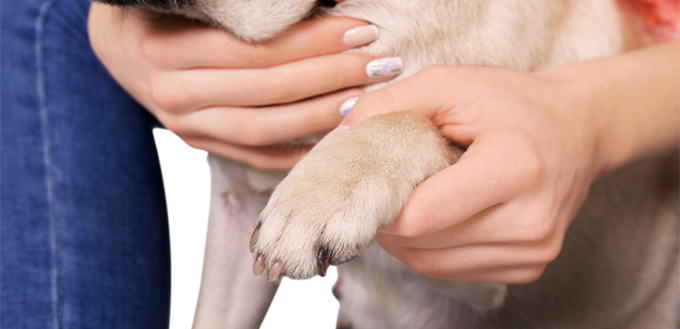It’s very distressing when your dog is limping. You know there’s something wrong but they can’t tell you what it is. Some pet owners can go straight to panic mode and imagine the worst. However, there could be an easily treatable reason why your dog is limping. You should contact your veterinarian as soon as you notice any signs of limping or lameness.

Two Types Of Lameness
There are two types of lameness – sudden onset, and gradual onset.
- Sudden Onset Limp
A sudden onset limp is exactly that. It happens suddenly and without any pre-warning. Dogs that suddenly start limping have usually suffered an injury or some sort of trauma. There are a number of injuries that could cause sudden limping.
- Gradual Onset Limp
A gradual limp happens over time. These kinds of limps are often caused by an underlying condition. You will need to call your veterinarian as soon as you notice an abnormal gait. Some conditions that cause gradual onset limping can be treated effectively if they have been diagnosed in good time.
Common Causes Of Limping
As mentioned earlier, there are a few common causes of limping. Some are severe, some are less severe, and some are mild. You should always contact your vet for advice whenever you notice your dog limping.
1. Sprains And Strains
Just like people, dogs can become injured by sprains or strains. Leg strains or sprains can be quite common and are often the cause of sudden onset limping.

If your dog is limping after a particularly long or difficult walk, it could be a sprain. In most cases, the injury resolves itself within a few days, but it may be more serious and need veterinary attention in some cases.
Check out our round-up of the Best Dog Knee Braces.
2. Ligament Damage
Ligament damage is one of the most common reasons for a dog limping. The cruciate ligament in your dog’s knees are a common injury site. The torn ligaments causes pain and a sudden limp.
It can be caused by a degeneration of the ligament or trauma. Some breeds, such as the Labrador, are more prone to ligament disease. Rest and medication may be enough to sort it but some cases require surgery by a veterinarian.
3. Osteoarthritis
Osteoarthritis is a joint disease often that an older dog may experience. Their muscles and skeleton weaken, and they can’t exercise or play like they used to be able to due to joint pain. Most owners admit that they do need to keep a close eye on their older dogs, as they often forget that they are no longer as able as they once were and joint health needs to become a priority. Osteoarthritis may be the reason for your older dog’s limp.
Arthritis can be managed with a care regime (which may include physical therapy), so always make sure you seek veterinary care. Some owners like to try joint supplements containing glucosamine or chondroitin or special food for senior dogs.
4. Luxating Patella
A luxating patella is a medical term for a dislocated knee and this can cause a dog’s limp.. This is when the kneecap has moved from its natural position. This can cause a variety of symptoms, from being unable to put weight on the leg, to instability when walking, and in some cases, the dog doesn’t seem to experience pain. Some breeds are more likely to have this condition than others. It’s also a hereditary condition, so if even one of the parents had it, then the resulting puppy is likely to have it.
Some dogs can have it and have no symptoms, and very little ill effect on their day-to-day life. Other dogs suffer pain, or it can worsen requiring surgery, or other treatment. It is also possible for a dislocated knee to occur as a result of some other trauma, or injury.
5. Paw Trouble
Some form of injury to the paw is a common cause of sudden limping. Check their pads for lacerations, but also remember it’s quite common for small foreign bodies to become stuck in your dog’s paw. If your dog’s limping also involves holding up one paw, carry out a physical examination of the affected leg for thorns, burrs, small sharp objects, or even mats between the toes of the paw pad.
6. Overexertion
If you notice your dog limping after rough play or a particularly long hike, then he may have simply overexerted himself. Dogs who have muscle aches from overexertion usually recover quite quickly, but you will need to book in with your vet for a physical exam if he needs pain relief, or if there is no noticeable improvement.
7. Toenail Trouble
Dogs limping can be caused by their nails. Toenail care is actually more important than many owners realize. Regular grooming, and walking on concrete can help keep the toenails filed, but he could still have an overgrown nail or an ingrown nail. Your groomer would be able to cut his nails, but if he has a severely ingrown nail, then your vet would need to deal with it. Another possible cause for toenail issues is that his nail has been cut too short.
You May Also Like: Dog Nail Clippers & Grinders
8. Animal Bites Or Insect Bites
Insect bites can contain venom and could be the cause if your dog starts suddenly limping. Spider bites can affect the dog’s neural system and are another cause of sudden lameness. Ticks can carry Lyme disease. Both Lyme disease and bites can cause sudden limping. Animal bites on your dog’s leg can be another potential cause. If your dog has been bitten by another dog or even a cat, he could be at risk of infection, bleeding, or this bite may have injured his joints.
9. Infection
Your dog’s limping may be due to an infection and this may need to be treated with antibiotics. You would need to see your veterinarian to get an appropriate medication, at an appropriate dosage. If an infection is left for a long period, it can become very difficult to treat. Infection is possible if there’s a wound, incision, skin irritation, or problem with the nail bed.
10. Scar Tissue
Scar tissue can form around an old injury or surgery site. Injuries, like broken bones, even if properly splinted and treated, can still develop scar tissue, or the bone may have set in a slightly different position. Injuries that involved complex fractures or injuries that have been treated with plates, pins, or screws can cause problems
11. Panosteitis
Limping in dogs can be caused by panosteitis which is also known as wandering lameness. This is a condition that affects large breed puppies between five to twelve months. It can cause pain and your dog’s ability to move around, moving from one leg to another over several weeks, or even months. In most cases, these symptoms disappear at around twenty months of age.
12. Dysplasia
Hip dysplasia and elbow dysplasia are quite common hereditary conditions, which can cause limping in dogs as well as pain. In hip dysplasia, the joint becomes loose and can dislocate easily. Your veterinarian will advise the best course of treatment depending on the severity of the hip dysplasia. They will also be able to provide pain medications. Dislocated joints such as hip dysplasia are more common is some breeds such the Great Dane.
13. Fractures And Broken Bones
A fracture or break can’t always be seen without an X-ray but can be the cause of limping in dogs. If your dog has a broken bone you may notice that he cannot put any weight on his leg – it could be either of the front or back legs. A break or fracture is often the result of a trauma and a broken leg requires immediate treatment and something to relieve pain. Contact your local veterinarian if your dog starts suddenly limping. In younger dogs, it can affect the way the limb grows in the future.
14. Nerve Damage
Nerve damage can cause paralysis in the legs, which would look like a limp. The dog will usually drag his foot on the ground. Nerve damage is common in dogs who have diabetes mellitus, so if you notice your dog dragging his foot, you should contact your veterinarian immediately.
15. Degenerative Myelopathy
Degenerative Myelopathy, or DM, is a progressive disease affecting the spinal cord. It’s common in older dogs, and symptoms include weakness and limping. This disease may progress to paralysis, so it’s very important to get a diagnosis, and management plan as soon as possible.
16. Cancer
You should make it part of your regular grooming routine to check your dog for any unusual lumps, or growths. They can be a sign of cancer, but they can also be something entirely benign.
However, always get any lumps checked, as cancer can often be treated if it has been caught in time. Bone cancer can spread quickly, cause pain, and can be a cause of dogs limp. This type of cancer is especially common in larger breeds but can affect any breed.
Related Post: Knuckling in Dogs – Symptoms, Causes, and Treatments
Sources:
- Dr. Jennifer Coates, Limping in Dogs, PetMD
- Scott H, 8 Reasons Your Dog May Be Limping, IHeartDogs
Leave a reply
Note: The advice provided in this post is intended for informational purposes and does not constitute medical advice regarding pets. For an accurate diagnosis of your pet's condition, please make an appointment with your vet.






Thanks for helping me understand the causes of why a dog could be limping. I had no idea that they could have received a fracture because of physical trauma, and they wouldn’t be able to put weight on their leg. My friend told me that her beagle has been limping since yesterday, and he’s also ignoring the meals she’s providing him. I’ll suggest that she take her beagle to an animal clinic as soon as she can.